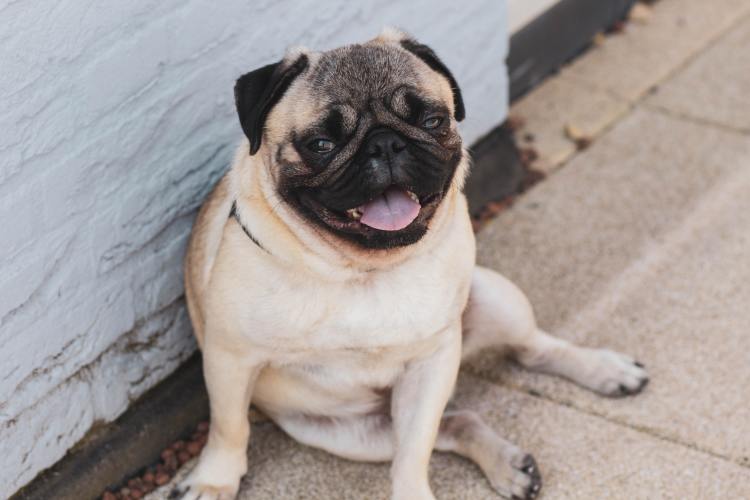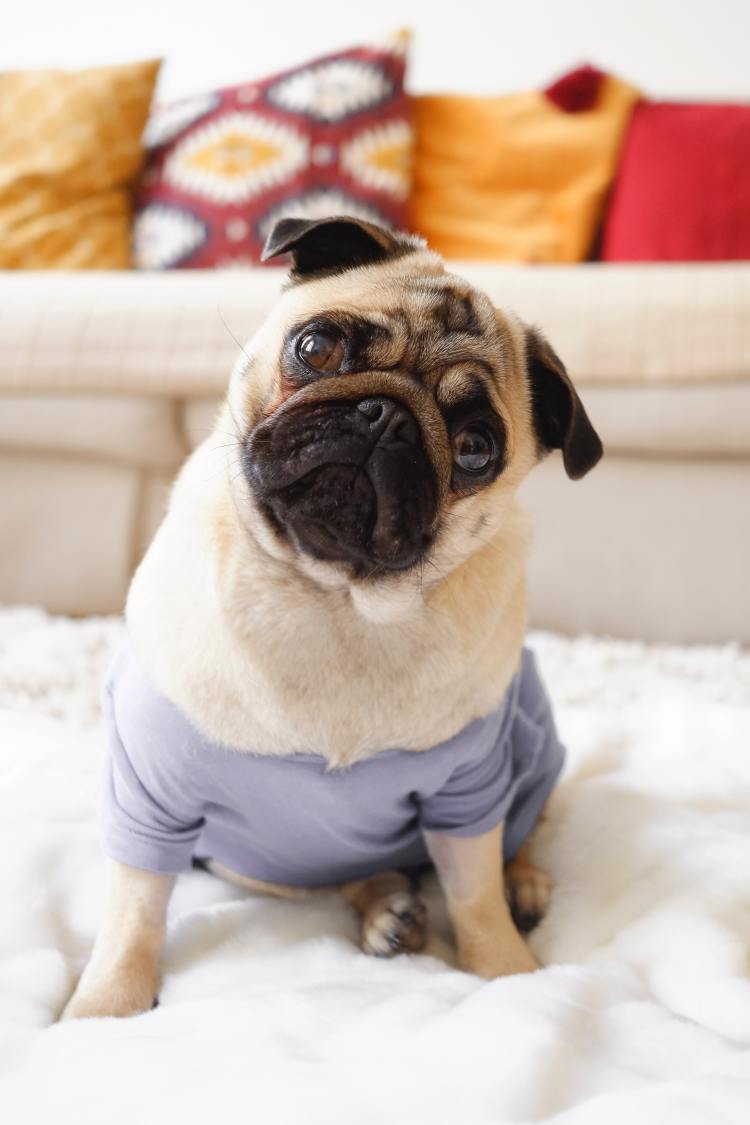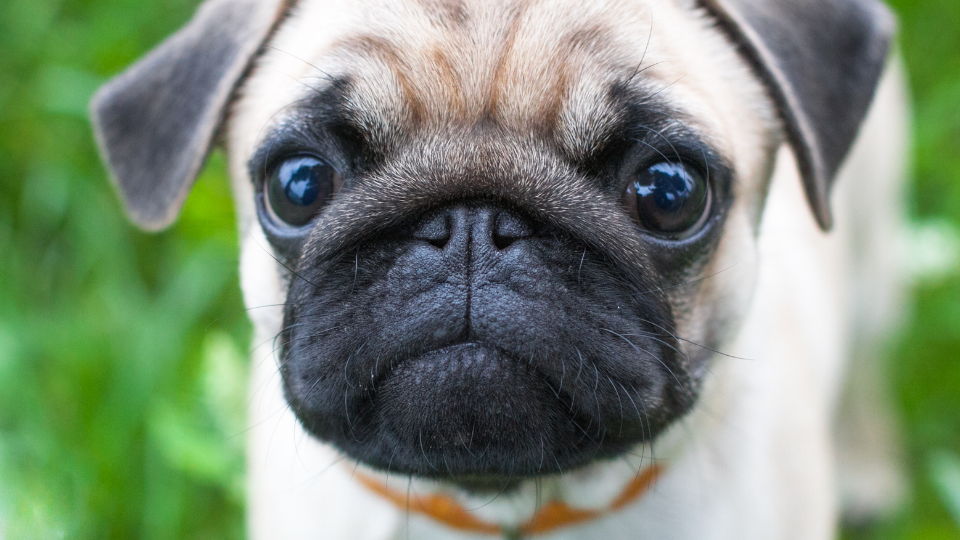Pugs are known for their clownish, mischievous nature, making them wonderful companion dogs to both children and adults. Their small size makes them excellent dogs for apartment living. Despite their goofy nature, Pugs were originally bred as companions to Chinese emperors and were made the mascot of Holland’s royal House of Orange after one Pug saved the prince from invading soldiers! These loving dogs adore being in your lap and having their affection returned. If you’re the lucky pet parent of this loving dog breed, you may be asking yourself how large will my Pug grow to be and when will they stop growing?
Everything you need to know about Pug growth:
- Pug Growth & Weight Chart
- At what age is a Pug fully grown?
- How big should a 6-month-old Pug be?
- How much bigger will my Pug get?
- What is the size of a full-grown Pug?
- How do I make sure my Pug is healthy?
Pug Growth & Weight Chart
Unlike many other dog breeds, gender does not impact the overall size and height of a Pug. Male and female Pugs grow at about the same rate and have roughly the same adult size. Please keep in mind that the following numbers are estimates and your Pug puppy may grow at a slightly different rate. Don’t be alarmed by this. Just continue taking your puppy to regular veterinarian appointments to have their health monitored and to receive personalized advice on how to best care for them.
Pro Tip: Ready to be reimbursed for up to 90% of your dog’s veterinary bills whenever they are sick or injured? Compare Pug pet insurance options now. Pet insurance helps you provide your Pug with top-notch veterinary care should the worst happen.
Pug Growth and Weight Chart
| Age | Weight |
|---|---|
| 1 month | 1 - 2 lbs |
| 2 months | 2 - 4 lbs |
| 3 months | 4 - 7 lbs |
| 4 months | 5 - 9 lbs |
| 5 months | 7 - 10 lbs |
| 6 months | 7 - 12 lbs |
| 7 months | 9 - 12 lbs |
| 8 months | 11 - 14 lbs |
| 9 months | 14 - 18 lbs |
| 10 months | 14 - 18 lbs |
| 11 months | 14 - 18 lbs |
| 1 year | 14 - 18 lbs |
At what age is a Pug fully grown?
Like many small dog breeds, Pugs reach their full size faster than medium to large-sized dogs. Pugs reach their adult size around nine months of age but may continue to put on a small amount of muscle until they are a year old.
 (Image Source: Pexels)
(Image Source: Pexels)
How big should a 6-month-old Pug be?
A six-month-old Pug will weigh between 7 and 12 pounds on average and will be close to their full adult height, which is typically around 10 to 13 inches tall. When measuring your Pug’s height, you should measure from their footpad to the top of their shoulders while they are standing.
Pugs are highly prone to putting on excess weight and their food intake needs to be monitored closely. The American Kennel Club has even labeled Pugs as one of the top “chowhound” dog breeds, which means that pet parents need to pay special attention to their pup’s diet due to the Pug’s tendency to overeat and beg for table scraps. If your Pug puppy is ahead of these estimates, it’s best to check in with your veterinarian to make sure that they are not gaining excessive weight which can be harmful to their joints and internal organs.
Pro Tip: Check out this ultimate pet parent guide with 39 dog care tips on health, puppy-proofing practices, training, winter and summer safety, and more!
How much bigger will my Pug get?
Pugs reach their full size around nine months of age but may continue filling out until they are a year old. If your Pug is younger than nine months old, they are definitely still growing!
Take a look at your Pug’s paws as well. If their paws look oversized next to their legs and body, they are likely still growing. This is a classic puppy feature that indicates that more growth is needed.
Lastly, try reaching out to your Pug’s breeder. Your breeder should be able to provide you with a more precise estimate of your Pug’s final size based on their parents and previous litters. A puppy will rarely grow to be larger than their bigger parent, so this will also give you an idea of their maximum size.
What is the size of a full-grown Pug?
According to the American Kennel Club Official Pug Standards, you can expect a full-grown Pug to weigh between 14 and 18 pounds and stand 10 to 13 inches tall. A full-grown Pug will appear compact and solid, rather than lean and leggy.
If your Pug continues to put on weight past 18 pounds, reach out to your veterinarian to assess whether your Pug is putting on excessive weight. Canine obesity is the most common, yet preventable disease in dogs, but it affects 25% to 30% of the general canine population according to the Veterinary Centers of America. If your Pug weighs more than 18 pounds, consult with your veterinary professional to ensure that they are at their healthiest weight.
 (Image Source: Pexels)
(Image Source: Pexels)
How do I make sure my Pug is healthy?
Pugs are loving, adorable dogs who are prone to many genetic health problems like cancer, kneecap dislocation, and skin irritation due to their skin’s folds. One of their most significant health problems is brachycephalic syndrome, which is commonly known as the cause of their “flat nose.” Brachycephalic syndrome obstructs a Pug’s airway making it harder for them to breath through their nose and results in higher rates of respiratory distress. Pugs are especially prone to heatstroke due to their compromised breathing. Maintaining a healthy weight is crucial to lessening the side effects of brachycephalic syndrome. In severe cases, surgery may be necessary to correct narrow nostrils or elongated soft palettes.
The rising cost of veterinary care and procedures can be stressful and affects important decisions that impact your Pug’s wellbeing. Many veterinary treatments and procedures cost thousands of dollars. When surveyed, Only 19.44% of pet parents would be able to cover a $5,000 expense out-of-pocket. 30.86% would seek out financing options such as a loan, relying on a credit card, or a payment plan through their veterinary clinic.
This is a crucial factor in why pet insurance is so valuable to pet parents. Pet insurance reimburses you a percentage of your out of pocket expenditure for veterinary bills. Not only can pet insurance provide you peace of mind should surgery or treatments be needed, but available wellness plans can significantly reduce the cost of routine veterinary exams or maintenance, like dog teeth cleaning or x-rays.
Your veterinarian is your greatest resource in keeping your pup happy and healthy. With your veterinary professional’s guidance and preventive care measures, like x-rays and physical exams, many health issues can be prevented or treated quickly and easily. Continue making healthy lifestyle choices, like daily exercise and a nutritious diet, for your Pug to keep them active and living their best life!
Final Considerations
It’s not surprising that Pugs are so popular between their charm, mischievous nature, and unending devotion to their loved ones.
Unfortunately, Pugs are prone to a larger number of health issues due to their brachycephalic syndrome and other genetic predispositions. No pet parent ever wants to think that their precious pup could get seriously hurt or sick, but it’s crucial to think ahead and prepare for anything that could happen.
Dog insurance works by reimbursing you for up to 90% of all out-of-pocket veterinary costs while acting as a safety net should the worst happen, so that you can provide your pet with the best care no matter the cost. Give yourself peace of mind today when you use Pawlicy Advisor to compare the top pet insurance options available, personalized to your Pug’s needs. Pawlicy Advisor can save you up to 83% on pet insurance costs over your dog’s lifespan.
